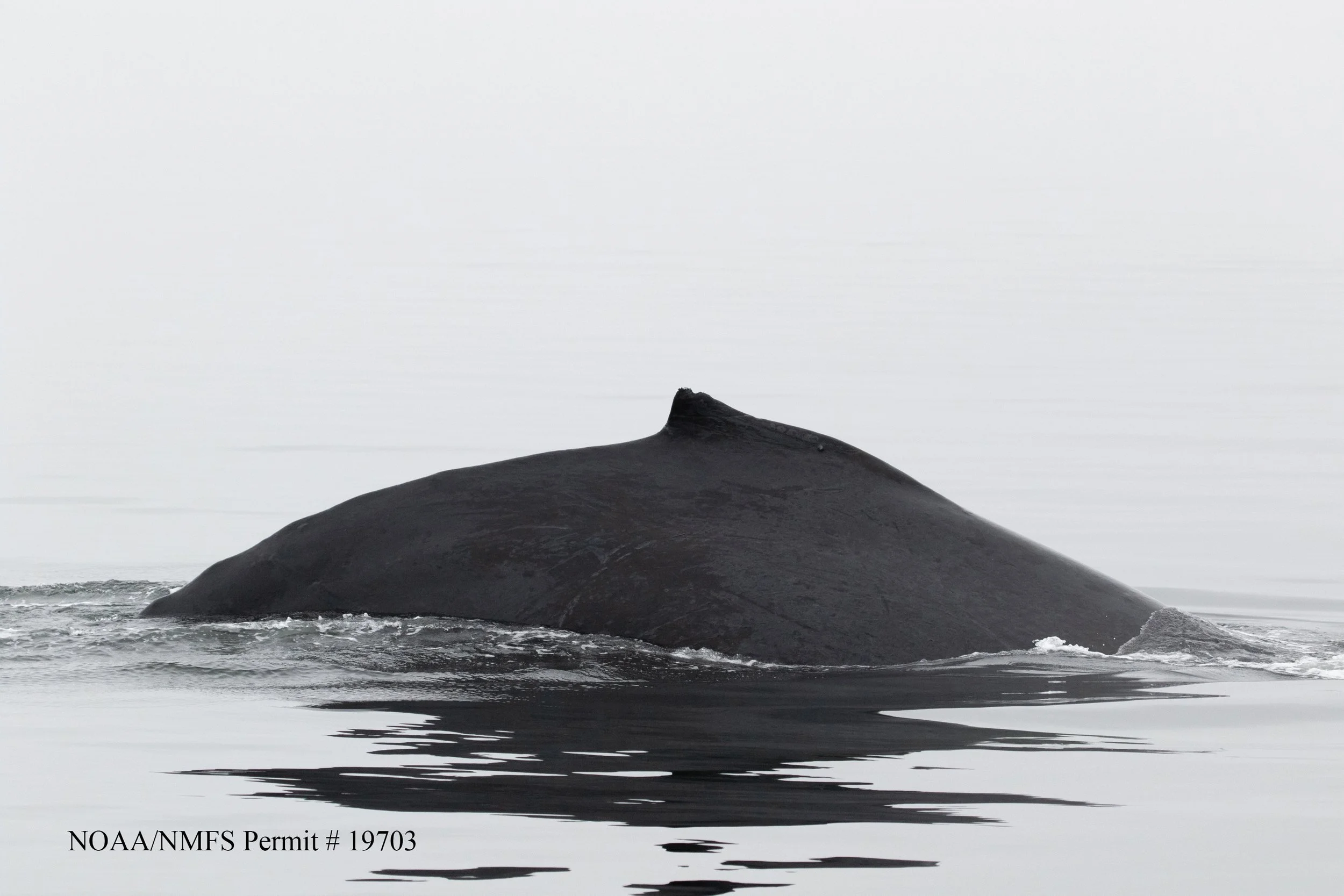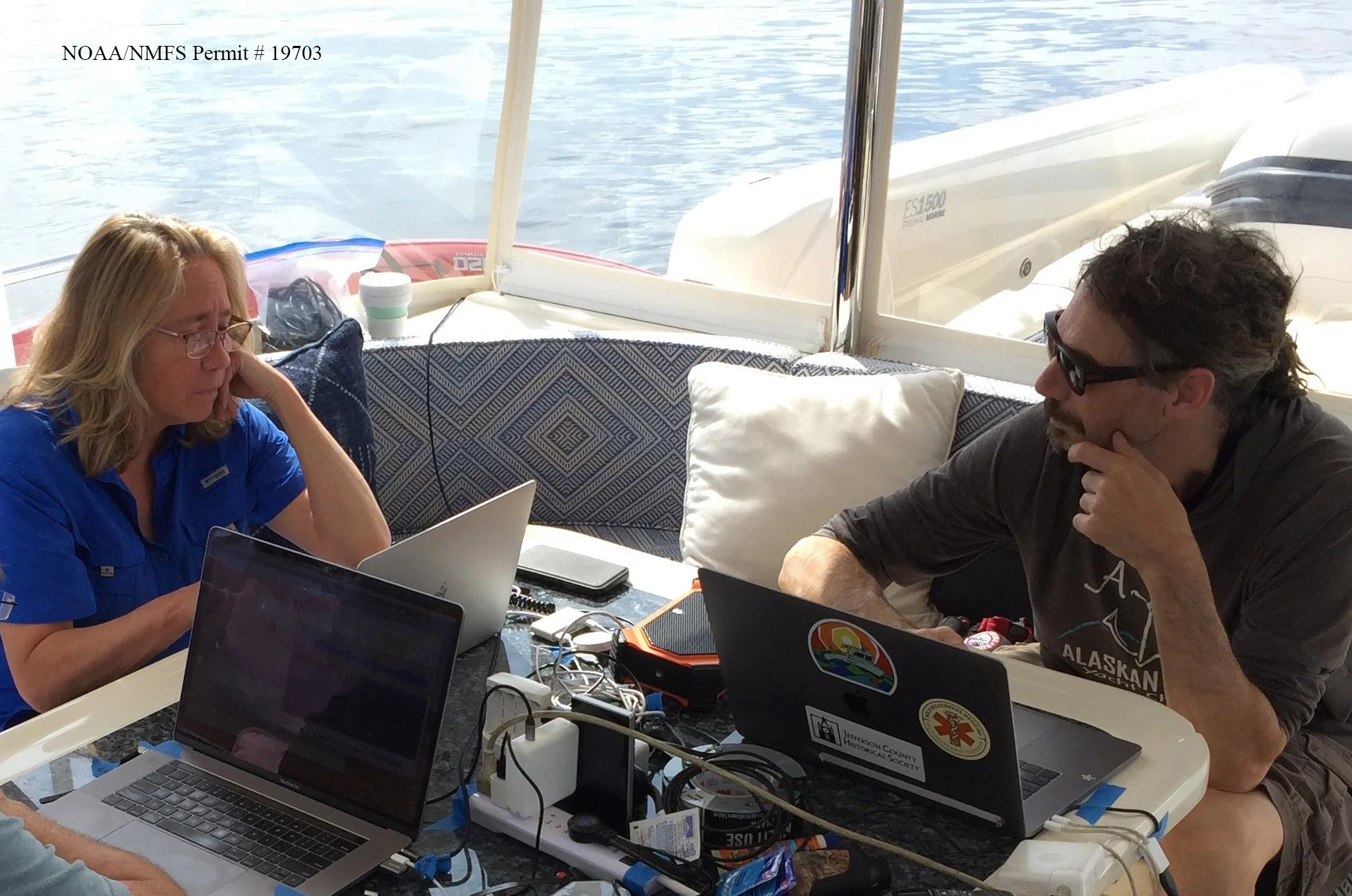“Conversing” With a Humpback Whale Named Twain
Guest blog by Jodi Frediani
Twain the Humpback Whale surfacing. ©Jodi Frediani
How many of us have wished for the day when we could hold a two-sided conversation with an animal, either one of our domestic friends or a wild one? Cartoons and TV shows have tried to take us there. And many authors have explored the topic. But in the real world, researchers are still hard at work trying to decipher the vocalizations and body language of the rest of the animal kingdom. I know I, and others, have longed since childhood for the secret key that would unlock the languages of other intelligent species on our planet.
Well, we are not alone in this desire! Researchers hold high hopes of being able to parse the various communications of non-human species here on earth. But why stop there? Some, including those from the SETI Institute (Search for Extra-terrestrial Life), are hoping that non-terrestrial ‘alien’ species on our planet may provide clues for under-standing which extraterrestrial signals are from intelligent and, likely curious, aliens. Making that breakthrough would be an added bonus!
So, it was with great pleasure that I found myself in southeast Alaska in the summer of 2021 plying the inland waterways in search of humpback whales, hoping for an interspecies conversation with them. My fellow sleuths on that voyage—members of the diversified Whale-SETI team—included Dr. Brenda McCowan, UC Davis professor of animal behavior; humpback whale researcher Dr. Fred Sharpe, founder of the Alaska Whale Foundation; Dr. Josephine Hubbard, doctoral student at UC Davis (now a post-doc) specializing in animal intelligences; Lisa Walker, Grooved Whale Project, a musician and humpback whale song theorist; and Dr. Laurance Doyle (via Zoom), astrophysicist with SETI, who employs information theory to understand the meaning of animal vocalizations. My contributions to the team include my skills as an accomplished marine-focused photographer and researcher with more than 20 years observing the behavior of humpback whales.
Brenda McCowan and Fred Sharpe. ©Jodi Frediani
During our 3-week field season that summer we played a variety of animal calls into the watery realm, and then we listened. Our tools included an underwater speaker along with a couple of hydrophones. During our first week at sea, we got no response. On Wednesday of our second week, we came across nine humpbacks milling in the general vicinity of our research vessel Glacier Seal. As we drifted with engines off in Frederick Sound, we deployed one of our hydrophones. We were able to record several humpback whale contact calls, also known as ‘whup’ calls, which are thought to be used by the whales to stay in touch. One of those calls was of such high quality, clear and vibrant, that the following day we decided to play it back to any whales that might be in the vicinity.
That day dawned gray with overcast skies. The sea was flat and calm with rising mists. Brenda began our playback trial by using a hydrophone to record all underwater sounds for 20 minutes to establish a baseline for later comparison. Then, at the start of the next 20-minute period, she played back the ‘juicy’ contact call exemplar we had recorded the day before. The rest of us onboard were auditorily ‘blind’ and stationed around the boat as observers, videographers and photographers. Brenda, inside the main cabin glued to her laptop and ‘blind’ to the action outside, listened and waited. She played the exemplar a second time and then again a third, before a whale approached our vessel and made a ‘whup’ call of its own. Those of us outside watched as the whale approached, came up for air, then dove only to resurface at a different location close to our boat. Again, Brenda played the exemplar and again, the whale replied.
Quite remarkably, this interchange continued for the full 20 minutes, the prescribed playback length allowed under our NOAA research permit (#19703). Wow! The whale we later identified as a 38-year-old female named Twain replied to our recorded whup call each of 33 times, engaging in conversational turn-taking as she remained a mere 100 meters from our vessel. Twain periodically came to the surface to breathe, then dove back down and again joined in a call and response with our exemplar. Throughout the 20-minute exchange, Twain consistently matched the interval variations between each playback call, dynamically adjusted by Brenda in response to the whale’s own call timing. Effectively, Twain responded in a conversational style.
When the 20 minutes of the playback period expired, Brenda sat back, but continued to listen as Twain repeated her ‘greeting’ call three more times, perhaps wondering why her conversational partner had seemingly disappeared. With no further response from us, Twain dove one last time and swam away.
Throughout the encounter, I photographed the solitary whale surfacing around our vessel, including photographs of her tail as she dove. Whales can be individually identified by the underside of their flukes. Their tails are akin to our fingerprints, different for each individual. Black and white coloration and scarring on the ventral side, as well as the peaks and indentations along the trailing edge of the tail all create a picture unique to each whale.
Twain the Humpback Whale’s fluke used for identification. ©Jodi Frediani
While still in the field we were able to enter the fluke photos into Happywhale.com, a citizen science fluke ID database. Instantly, we learned that they belonged to a female first identified in 1987 in Hawaii. Twain has since been sighted at least 27 times feeding in the inland waters of southeast Alaska. And, significantly, it turns out that Twain was present the day before our ‘conversation,’ when we recorded the whup call exemplar three nautical miles from our playback location. Was it her own voice she was responding to? Or one of her companions from the day before? What did Twain make of the exchange? Was it like saying ‘hello’ repeatedly and only getting ‘hello’ in response? She did seem to show a bit of possible frustration midway, beginning to exhale with wheezy blows as we continued to play back the same exemplar. But still, Twain did not stop calling until after we had stopped. Now we have the opportunity to reflect on how to improve any future interspecies dialogues.
We have described and analyzed the encounter in a paper entitled “Interactive Bioacoustic Playback as a Tool for Detecting and Exploring Nonhuman Intelligence: “Conversing” with an Alaskan Humpback Whale,” published in the journal PeerJ. The importance of our call-and-response close encounter with a non-human (aquatic) intelligence cannot be overstated. Lead author Dr. Brenda McCowan has explained the significance of this whale conversation, stating, “We believe this is the first such communicative exchange between humans and humpback whales in the humpback ‘language.'” And coauthor Dr. Fred Sharpe noted, “Humpback whales are extremely intelligent, have complex social systems, make tools—like nets out of bubbles to catch fish—and communicate extensively with both songs and social calls.” Coauthor Dr. Laurance Doyle added, “Because of current limitations on technology, an important assumption of the search for extraterrestrial intelligence is that extraterrestrials will be interested in making contact and so target human receivers. This important assumption is certainly supported by the behavior of humpback whales.”
Fred Sharpe and Laurance Doyle. ©Jodi Frediani
While we are still a long way from understanding what animals are saying to one another, let alone to us, this is a step in the right direction. At least it appears that the whales may be just as interested in expanding their understanding of us as we are of them. Maybe one day they will even help us in our efforts to grab the attention of and communicate with extraterrestrials.




